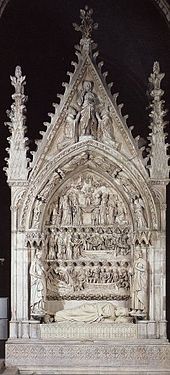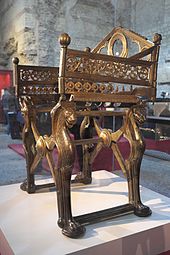Dagobert I.


Dagobert I (around 608 or 610 ; † January 19, 639 in Épinay-sur-Seine ) was sub-king in Austrasia since 623 and king of the Franks since 629 . Dagobert was the son of King Chlothar II and is traditionally considered the last important ruler of the Merovingian family .
Life
Only a few sources report on Dagobert's reign (according to the Fredegar Chronicle ), which is generally rated positively in research. However, the thin and sometimes very tendentious sources do not allow the king to be captured precisely as a person, especially since it is not always possible to trace back actions ascribed to him specifically to Scrooge's policy.
In 623 Dagobert was installed as subordinate ruler in Austrasia by his father Chlothar. Some territories had been separated from this new sub-kingdom, but in 625/26 he enforced an expansion of his dominion. In 629 Dagobert became king of the entire empire. In 632, after the death of his half-brother Charibert II , his son Chilperich also died ; Dagobert is said to have been involved in Chilperich's death, but this is not certain. In any case , Dagobert now had Burgundy and Aquitaine under his rule. He was the most powerful of the Merovingian kings and the most respected Western ruler of his time.
The Merovingian rulers before Dagobert had recently lost much of their power; Dagobert managed to reverse this process again for a few years. As general ruler, he made Paris his residence, the administration was still partly based on the late antique Roman administrative pattern. His advisers were initially the caretaker Pippin the Elder , the progenitor of the Pippinids , and the bishop Arnulf von Metz , who were both progenitors of the Carolingians . However, Arnulf withdrew in 629; Dagobert reduced the influence of his house keeper Pippin after he had taken control of the entire empire. While the Fredegar chronicle rated Scrooge's royal time in Austrasia positively, the chronicle made serious accusations for the period after 629: Scrooge had given himself completely to carnal lust (luxuria) and enriched himself at the church. The core of this criticism is apparently Dagobert's energetic domestic policy, which opened up new sources of taxation and did not exclude the rich and influential Church.
In the aristocracy there was also some resistance to Dagobert, but the king seems to have been successful in domestic politics and, above all, to have acted independently. The very religious Dagobert was responsible for building the Saint-Denis basilica near the Benedictine monastery north of Paris, where the king's memory was cherished long after his death. The economic situation was stable; Several new gold coins have survived that were minted in Scrooge's time, mainly from the Limoges mint .
Dagobert was sometimes quite successful in foreign policy. The Eastern Roman Emperor Herakleios had contacted Dagobert, and it was probably on the Eastern Roman initiative that Jews were forced to baptize in the Merovingian Empire . In addition, Herakleios sent him a precious cross relic around 630 (it was destroyed after 1789). In the south-west, Dagobert managed a successful campaign against the Basques in 636/37 ; Judicael, king of the Bretons , also submitted.
On the other hand, Dagobert also suffered defeats, like against the Slavs . The Slav campaign against their ruler Samo failed in 631. The situation on the border with the Slavs remained tense, but Dagobert secured the border area through agreements with the Saxons and the Thuringians . The failure against Samo probably ensured that he came under fire from parts of the Frankish nobility. Dagobert put his son Sigibert III in 633 . , then still a toddler, as a sub-king in Austrasia. However, it is unclear whether this appointment can be interpreted as a weakness of Scrooge against the nobility, since the corresponding main source (the Fredegar Chronicle) generally tends to weaken Scrooge's authority as king. 634 Dagobert declared that he was ready to make a succession arrangement in the event of death. Accordingly, the kingdom should be divided among his sons. The plan should also take into account the concerns of the Neustrian nobility against paternalism from Austrasia.
Dagobert seems to have been quite interested in the Christianization policy of various missionaries in the fringes of the empire, which indirectly also increased the Frankish sphere of influence.
Marriages and offspring
Dagobert I. married four times. In 625 he married Gomatrud , a sister of Sigihild , the third wife of his father. In 629 he separated from her because the marriage had remained childless, and married the Saxon Nantechild , who survived him and after his death took over the reign of her underage son. Wulfegundis and Berchildis are named as other wives; the latter probably belonged to a ring with the inscription Berteildis regina . When these marriages began and how long they lasted is unknown.
From Nantechild he had his only legitimate child, who later became King Clovis II (634–657). With Ragnetrud, Nantechilde's niece, he had another son out of wedlock four years earlier, the future King Sigibert III. (630-656).
Succession and posthumous biography
After Scrooge's death, the kingdom was divided between his two sons. Sigibert III. received Austrasia with residence in Metz , the younger Clovis II Neustria and Frankoburgund with residence in Paris . The decentralized area then fell into disrepair due to a number of weak and incompetent rulers. Meanwhile, noble families were able to gain more and more power and take control of the country. The most important of these families were the Carolingians . Attempts by some kings to regain actual rule in the late 7th century failed.
Dagobert was the first Frankish king to be buried in the royal tomb of St. Denis. It was there two hundred years later, probably by Abbot Hilduin's hand , that Gesta Dagoberti's transfigured biography was written . When the royal tombs of Saint-Denis were sacked during the French Revolution , his grave was opened and looted on October 19, 1793, and his remains were buried in a mass grave outside the church.
In folk tales , Dagobert I is described as "the good King Dagobert". The song of the same name "Le bon roi Dagobert" probably dates from the time of the French Revolution .
The legend of Notburga von Hochhausen is also linked to Dagobert I. Various traditions related to his name in the High Middle Ages, especially when attempts were made to claim a particularly old tradition (e.g. Dagobert's donation in Soest ).
Lex Ripuaria
The law collection Lex Ripuaria , which was most likely published during the reign of Dagobert I in Austrasia , summarized orally handed down law of the Rhine Franks ; however, the dating is controversial in recent research. The 89 chapters, especially those of the second part (of three parts), were strongly influenced by the Lex Salica , which the Merovingian Clovis I had published between 507 and 511 as the code of the Salian Franks .
literature
- Maurice Bouvier-Ajam: Dagobert. Tallandier, Paris 1980, ISBN 2-235-00821-6 .
- Hans Hubert Anton : Dagobert I. In: Reallexikon der Germanischen Altertumskunde (RGA). 2nd Edition. Volume 5, Walter de Gruyter, Berlin / New York 1984, ISBN 3-11-009635-8 , pp. 177-178.
- Peter Classen : Dagobert I. In: New German Biography (NDB). Volume 3, Duncker & Humblot, Berlin 1957, ISBN 3-428-00184-2 , p. 474 f. ( Digitized version ).
- Eugen Ewig : The Merovingians and the Franconian Empire (= Kohlhammer-Urban pocket books. Vol. 392). 4th, supplemented edition. Kohlhammer, Stuttgart et al. 2001, ISBN 3-17-017044-9 .
- Patrick J. Geary : The Merovingians. Europe before Charlemagne (= Beck'sche series. 1507). Updated new edition. Beck, Munich 2003, ISBN 3-406-49426-9 .
- Sebastian Scholz : The Merovingians. Kohlhammer, Stuttgart 2015, ISBN 978-3-17-022507-7 , pp. 204ff.
- Christoph Wehrli: Medieval traditions from Dagobert I (= spirit and work of the times. No. 62). Lang, Bern et al. 1982, ISBN 3-261-04914-6 (also: Zurich, university, dissertation).
Web links
Remarks
- ↑ For the dating see Margarete Weidemann: Zur Chronologie der Merowinger im 7. und 8. Century . In: Francia . Vol. 25, No. 1, 1998, pp. 177-230, here pp. 179 f.
- ↑ See for example Patrick J. Geary: Die Merowinger. Munich 2003, p. 154ff.
- ↑ Sebastian Scholz: The Merovingians. Stuttgart 2015, pp. 213f.
- ↑ Fredegar IV 60.
- ↑ Sebastian Scholz: The Merovingians. Stuttgart 2015, p. 212.
- ↑ Sebastian Scholz: The Merovingians. Stuttgart 2015, pp. 209f.
- ↑ Sebastian Scholz: The Merovingians. Stuttgart 2015, p. 210f.
- ↑ Sebastian Scholz: The Merovingians. Stuttgart 2015, p. 211.
- ↑ Sebastian Scholz: The Merovingians. Stuttgart 2015, p. 213.
- ↑ Sebastian Scholz: The Merovingians. Stuttgart 2015, pp. 214f.
| predecessor | Office | successor |
|---|---|---|
|
Chlothar II. Fellow kings in the special kingdom of Aquitaine up to about 632 Charibert II. Chilperic of Aquitaine |
King of the Franks from 629 to 639 |
Sigibert III. in Austrasia Clovis II in Neustria and Burgundy |
| personal data | |
|---|---|
| SURNAME | Dagobert I. |
| BRIEF DESCRIPTION | Merovingian King of the Franconian Empire (629–639) |
| DATE OF BIRTH | at 609 |
| DATE OF DEATH | January 19, 639 |
| Place of death | Épinay-sur-Seine |
